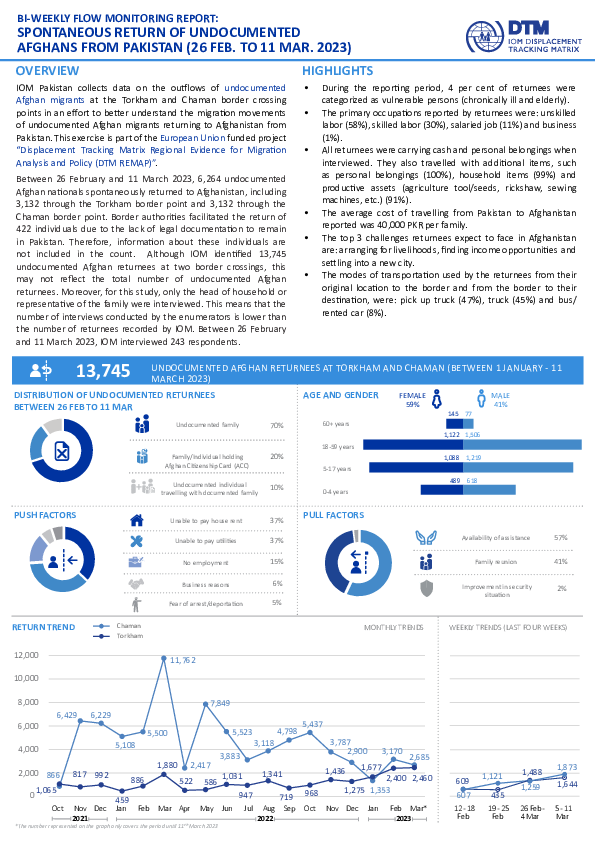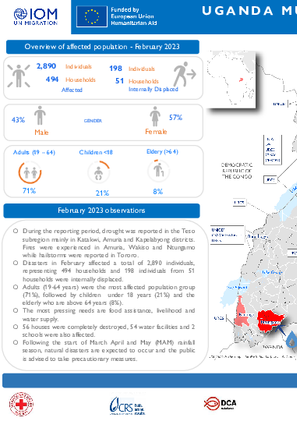-
Countries
-
Data and Analysis
-
Special Focus
-
Crisis Responses

Contact
DTM Mozambique, DTMMozambique@iom.int
Language
English
Location
Mozambique
Period Covered
Feb 24 2023
Mar 17 2023
Activity
- Other
Mozambique’s National Institute for Disaster Management (INGD) estimates 565,000 people to be affected by the second landfall of Tropical Storm Freddy - directly impacting communities of Zambezia, Sofala and Tete. As of 10 March, INGD have identified at approximately 240,000 people already affected by the first landfall of Tropical Storm Freddy (24 February) as well as recent floods recorded in central and southern Mozambique. As of 17 March 2023, available reports indicate 37,302 individuals (7,460 families) in 94 ACs across Zambezia, 40,475 individuals (8,811 families) have taken shelter in 61 accommodation centres (ACs) across Sofala, 12,344 individuals (2,607 families) in 28 ACs across Tete, 3,634 individuals (792 families) in 15 ACs across Inhambane, 64 individuals (13 families) in 1 AC in Gaza, 318 individuals (77 families) in 5 ACs across Manica, and 2,361 individuals (494 families) in 6 AC in Niassa. The majority of these centres are schools and churches. Reported priority needs include WASH, protection, health, food and emergency shelters. As rain and flood events develop, ongoing joint assessments with INGD and humanitarian partners monitor the needs and conditions of affected populations in the region. While movements remain dynamic in Zambezia impacted districts, accomadation Centres out of the reported 94 Accomadstion Centres require further validation.
Contact
DTM Mozambique, DTMMozambique@iom.int
Location
Mozambique
Activity
- Mobility Tracking
- Event Tracking
Period Covered
Feb 24 2023 -Apr 10 2023
Population Groups
Survey Methodology
Unit of Analysis Or Observation
Type of Survey or Assessment
Keywords
Geographical Scope
Administrative boundaries with available data
The current dataset covers the following administrative boundaries

Contact
DTM Nigeria, iomnigeriadtm@iom.int
Language
English
Location
Nigeria
Period Covered
Mar 06 2023
Mar 12 2023
Activity
- Mobility Tracking
- Event Tracking
The DTM Emergency Tracking Tool (ETT) is deployed to track and to collect information on large and sudden population movements, provide frequent updates on the scale of displacement and quantify the affected population when needed. As a sub-component of the Mobility Tracking methodology in Nigeria, ETT utilises direct observations and a broad network of key informants to capture best estimates of the affected population per location, enabling targeted humanitarian response planning.
Between 06 and 12 March 2023, a total of 2,643 new arrivals were recorded in locations in Adamawa and Borno states. The new arrivals were recorded at locations in Askira/Uba, Bama, Biu, Dikwa, Damboa, Gwoza, Monguno, Ngala, and Kala Balge Local Government Areas (LGAs) of the most conflict-affected state of Borno and in Fufore, Gombi, Hong, Lamurde, Michika, Maiha, Mubi South, Mubi North, Numan, Song, Yola South and Yola North LGAs of Adamawa state.

Contact
DTM Pakistan, iomisbdtmremapteam@iom.int
Language
English
Location
Pakistan
Period Covered
Feb 26 2023
Mar 11 2023
Activity
- Flow Monitoring
Between 26 February and 11 March 2023, 6,264 undocumented Afghan nationals spontaneously returned to Afghanistan, including 3,132 through the Torkham border point and 3,132 through the Chaman border point. Border authorities facilitated the return of 422 individuals due to the lack of legal documentation to remain in Pakistan. Therefore, information about these individuals are not included in the count. Although IOM identified 13,745 undocumented Afghan returnees at two border crossings, this may not reflect the total number of undocumented Afghan returnees. Moreover, for this study, only the head of household or representative of the family were interviewed. This means that the number of interviews conducted by the enumerators is lower than the number of returnees recorded by IOM. Between 26 February and 11 March 2023, IOM interviewed 243 respondents.

Contact
DTM Libya, DTMLibya@iom.int
Language
English
Location
Libya
Snapshot Date
Dec 31 2022
Activity
- Other
In 2022, 15,228 migrants from Bangladesh arrived in Italy via the Central Mediterranean Route (CMR) with a majority transiting through Libya. Migrants from Bangladesh constituted slightly more than 14 per cent of all arrivals in Italy — the third most-represented nationality.
As of December 2022 (DTM Round 45), there were 21,653 migrants from Bangladesh in Libya accounting for 3 per cent of the total migrant population in the country — the seventh most-represented nationality. In 2022, a total of 4,448 migrants from Bangladesh were intercepted and returned to Libya while crossing the Mediterranean Sea. The number of migrants from Bangladesh present in detention centres in Libya also remained high with over 2,000 migrants detained throughout the year.
This brief outlines the route travelled by migrants from Bangladesh to reach Libya as well as their migratory movements through the Central Mediterranean Route.

Contact
DTM Uganda, dtmuganda@iom.int
Language
English
Location
Uganda
Period Covered
Feb 01 2023
Feb 28 2023
Activity
- Mobility Tracking
During the reporting period, drought was reported in the Teso subregion mainly in Katakwi, Amuria and Kapelabyong districts. Fires were experienced in Amuria, Wakiso and Ntungamo while hailstorms were reported in Tororo. Disasters in February affected a total of 2,890 individuals, representing 494 households and 198 individuals from 51 households were internally displaced. Adults (19-64 years) were the most affected population group (71%), followed by children under 18 years (21%) and the elderly who are above 64 years (8%). The most pressing needs are food assistance, livelihood and water supply. 56 houses were completely destroyed, 54 water facilities and 2 schools were also affected. Following the start of March April and May (MAM) rainfall season, natural disasters are expected to occur and the public is advised to take precautionary measures.

Contact
DTM Nigeria, iomnigeriadtm@iom.int
Language
English
Location
Nigeria
Period Covered
Feb 27 2023
Mar 05 2023
Activity
- Mobility Tracking
- Event Tracking
The DTM Emergency Tracking Tool (ETT) is deployed to track and to collect information on large and sudden population movements, provide frequent updates on the scale of displacement and quantify the affected population when needed. As a sub-component of the Mobility Tracking methodology in Nigeria, ETT utilises direct observations and a broad network of key informants to capture best estimates of the affected population per location, enabling targeted humanitarian response planning.
Between 27 February and 05 March 2023, a total of 1,338 new arrivals were recorded in locations in Adamawa and Borno states. The new arrivals were recorded at locations in Askira/Uba, Bama, Dikwa, Gwoza, Gubio, Monguno, and Kala Balge Local Government Areas (LGAs) of the most conflict-affected state of Borno and in Gombi, Hong, Song, Yola South and Yola North LGAs of Adamawa state.

Contact
DTM Nigeria, iomnigeriadtm@iom.int
Language
English
Location
Nigeria
Period Covered
Mar 09 2023
Mar 11 2023
Activity
- Mobility Tracking
- Event Tracking
On March 9 and 11, several fire outbreaks were reported in the camps of Shuwari, Masarmari, and 1000 in Dikwa LGA in Borno State. The fire outbreak affected a total of 237 individuals and destroyed 41 shelters. The affected individuals include 118 children, 84 women, and 35 men. The majority of those affected by the fire outbreaks lost their personal items in the fire, including food allotment cards and biometric cards. The fire outbreak was caused by the wind spreading cooking fires. No injuries or deaths were reported.
While the affected populations are working to rebuild their shelters, they presently live with their neighbours in the same camp.

Contact
DTM Nigeria, iomnigeriadtm@iom.int
Language
English
Location
Nigeria
Period Covered
Mar 03 2023
Mar 06 2023
Activity
- Mobility Tracking
- Event Tracking
On 3 and 6 March 2023, fire outbreaks were reported in Muna El Badawy camp in Jere LGA in Borno State. A total of 1,675 individuals were affected by the fire outbreaks as a total of 16 shelters were damaged and destroyed. The affected population included 834 children, 538 women, and 303 men. Most of the affected people lost their personal belongings to the fire, including biometric cards and food ration cards. No injuries or fatalities were reported and the cause of the fire is unknown. The affected individuals are currently residing with their neighbours in the same camp while they work to rebuild their shelters.

Contact
DTM Ethiopia, DTMEthiopia@iom.int
Language
English
Location
Ethiopia
Period Covered
Jan 01 2023
Jan 31 2023
Activity
- Flow Monitoring
In January 2023, a total of 33,109 movements were observed across five of Ethiopia's flow monitoring points (FMPs). This represents a 3.5% increase in daily average movements in comparison with December 2022 when an average of 1,031 movements per day were observed.
Outgoing movements during January have continued to be higher (75.1%) than incoming movements (24.9%). A total of 24,872 outgoing movements were observed of which 9,618 (38.7%) were heading towards Saudi Arabia, 3,156 (12.7%) were going to Djibouti, 3,004 (12.1%) were travelling towards Kenya, 2,104 (8.5%) to Somalia, 1,765 (7.1%) intended to reach Sudan, 1,249 (5%) headed to Yemen, 706 (2.8%) to Qatar and 578 (2.3%) to the United Arab Emirates while remaining movements were travelling to several Middle Eastern, Southern Africa, European and North American countries.
At the same time, 8,237 incoming movements were observed, of which 3,245 (39.4%) had originated from Sudan, while 2,066 (25.1%) came from Djibouti, 1,607 (19.5%) from Kenya, 1,105 (13.4%) movements from Somalia, 186 (2.3%) from Yemen and the remaining from the United Republic of Tanzania, Belgium, the United States of America, Spain, Poland, the Russian Federation, France and Liberia. Almost all of these were Ethiopian nationals who were likely returning home.